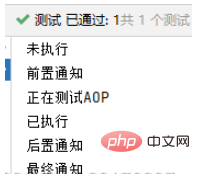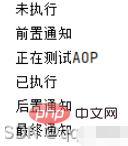How to use aop in SpringBoot project
Preface
IOC and AOP are the two core concepts in Spring. Let me briefly introduce my understanding:
IOC: Inversion of control, which is to manually create the The object process is handed over to Spring. Spring helps us produce objects, manage objects, manage objects and the dependencies between objects. It reduces the coupling of the code and facilitates our later maintenance of the project. To give a more popular example:
Under normal circumstances, we are at home, hungry, and cook by ourselves.
When using IOC, when we are at home and hungry, we call the merchant and the food is delivered.
IOC is equivalent to a merchant, and cooking is equivalent to creating an object.
That is to say, under normal circumstances, when a class needs to call methods of other classes, we manually create objects through new, factory or other methods.
When using IOC, we only need to inject the object.
AOP: Aspect-oriented (convenient) programming, you can supervise and control a certain type of object, call the specified code before and after calling the method of this type of object, thereby extending a method to achieve enhancement Effects of module functionality. To give a simple example:
Under normal circumstances, eat directly.
When using AOP, a nanny is watching over you, helping you wash your hands before eating and cleaning up the dishes after eating.
AOP is equivalent to a nanny, and eating is equivalent to calling specific methods.
In other words, when we want to supplement the method, we do not modify the method directly, but supplement it through AOP. When we don't want to replenish or need to replace the replenishment, we can directly operate the AOP.
1. Pointcut: Pointcut, used to define which method will be intercepted, such as execution(* cn.springcamp.springaop.service..(…))
2. Advice: Intercepted method Actions to be executed later
3. Aspect: Aspect, combine Pointcut and Advice to form an aspect
4. Join Point: An instance of Pointcut during execution
4. Weaver: A framework that implements AOP, such as AspectJ or Spring AOP
1. The SpringBoot project introduces AOP dependencies
<!--aop-->
<dependency>
<groupId>org.springframework.boot</groupId>
<artifactId>spring-boot-starter-aop</artifactId>
</dependency>The startup class is added with the @EnableAspectJAutoProxy annotation, which can be omitted. Because in the default configuration properties of AOP, the spring.aop.auto property is turned on by default.
There is no need to introduce AspectJ dependencies anymore.
2. Ordinary method
Aspect class code:
package com.example.myblog.test;
import org.aspectj.lang.JoinPoint;
import org.aspectj.lang.ProceedingJoinPoint;
import org.aspectj.lang.annotation.*;
import org.springframework.stereotype.Component;
@Component
@Aspect
public class AOPTest {
//定义切入点
@Pointcut("execution(public * com.example.myblog.test.AOPTestClient.*(..))")
public void aspectTest(){}
//前置通知,切入点执行之前执行
@Before("aspectTest()")
public void doBefore(JoinPoint joinPoint){
System.out.println("前置通知");
}
//后置通知,切入点执行之后执行
@After("aspectTest()")
public void doAfter(JoinPoint joinPoint){
System.out.println("后置通知");
}
//最终通知,,切入点执行之后执行
@AfterReturning("aspectTest()")
public void doAfterReturning(JoinPoint joinPoint){
System.out.println("最终通知");
}
//异常通知,切入点抛出异常执行
@AfterThrowing("aspectTest()")
public void deAfterThrowing(JoinPoint joinPoint){
System.out.println("异常通知");
}
//环绕通知,切入点执行前、后执行
@Around("aspectTest()")
public Object deAround(ProceedingJoinPoint joinPoint) throws Throwable{
System.out.println("未执行");
Object result = joinPoint.proceed();
System.out.println("已执行");
//返回结果
return result;
}
}Pointcut class code:
package com.example.myblog.test;
import org.springframework.stereotype.Component;
@Component
public class AOPTestClient {
public void test(){
System.out.println("正在测试AOP");
}
}Test class code:
package com.example.myblog;
import com.example.myblog.test.*;
import org.junit.Test;
import org.junit.runner.RunWith;
import org.springframework.beans.factory.annotation.Autowired;
import org.springframework.boot.test.context.SpringBootTest;
import org.springframework.test.context.junit4.SpringJUnit4ClassRunner;
@SpringBootTest
@RunWith(SpringJUnit4ClassRunner.class)
public class MyblogApplicationTests {
@Autowired
private AOPTestClient aopTestClient;
@Test
public void testAOP(){
aopTestClient.test();
}
}Test results:

3. Annotation method
Custom annotation code:
package com.example.myblog.test;
import java.lang.annotation.ElementType;
import java.lang.annotation.Retention;
import java.lang.annotation.RetentionPolicy;
import java.lang.annotation.Target;
//表示次注解可以标注在类和方法上
@Target({ElementType.METHOD, ElementType.TYPE})
//运行时生效
@Retention(RetentionPolicy.RUNTIME)
public @interface MyAnnotation {
//定义一个变量,可以接受参数
String desc() default " ";
}Aspect class code:
package com.example.myblog.test;
import org.aspectj.lang.JoinPoint;
import org.aspectj.lang.ProceedingJoinPoint;
import org.aspectj.lang.annotation.*;
import org.springframework.stereotype.Component;
@Component
@Aspect
public class AOPAnnotationTest {
//定义切入点
@Pointcut("@annotation(com.example.myblog.test.MyAnnotation)")
public void aspectTest(){}
//前置通知,切入点执行之前执行
@Before("aspectTest()")
public void doBefore(JoinPoint joinPoint){
System.out.println("前置通知");
}
//后置通知,切入点执行之后执行
@After("aspectTest()")
public void doAfter(JoinPoint joinPoint){
System.out.println("后置通知");
}
//最终通知,,切入点执行之后执行
@AfterReturning("aspectTest()")
public void doAfterReturning(JoinPoint joinPoint){
System.out.println("最终通知");
}
//异常通知,切入点抛出异常执行
@AfterThrowing("aspectTest()")
public void deAfterThrowing(JoinPoint joinPoint){
System.out.println("异常通知");
}
//环绕通知,切入点执行前、后执行
@Around("aspectTest()")
public Object deAround(ProceedingJoinPoint joinPoint) throws Throwable{
System.out.println("未执行");
Object result = joinPoint.proceed();
System.out.println("已执行");
//返回结果
return result;
}
}Pointcut class code:
package com.example.myblog.test;
import org.springframework.stereotype.Component;
@Component
public class AOPAnnotationTestClient {
@MyAnnotation
public void test(){
System.out.println("正在测试AOP");
}
}Test class code:
@Test
public void testAOPAnnotation(){
aopAnnotationTestClient.test();
}Test result:

The above is the detailed content of How to use aop in SpringBoot project. For more information, please follow other related articles on the PHP Chinese website!

Hot AI Tools

Undresser.AI Undress
AI-powered app for creating realistic nude photos

AI Clothes Remover
Online AI tool for removing clothes from photos.

Undress AI Tool
Undress images for free

Clothoff.io
AI clothes remover

Video Face Swap
Swap faces in any video effortlessly with our completely free AI face swap tool!

Hot Article

Hot Tools

Notepad++7.3.1
Easy-to-use and free code editor

SublimeText3 Chinese version
Chinese version, very easy to use

Zend Studio 13.0.1
Powerful PHP integrated development environment

Dreamweaver CS6
Visual web development tools

SublimeText3 Mac version
God-level code editing software (SublimeText3)

Hot Topics
 1386
1386
 52
52
 How Springboot integrates Jasypt to implement configuration file encryption
Jun 01, 2023 am 08:55 AM
How Springboot integrates Jasypt to implement configuration file encryption
Jun 01, 2023 am 08:55 AM
Introduction to Jasypt Jasypt is a java library that allows a developer to add basic encryption functionality to his/her project with minimal effort and does not require a deep understanding of how encryption works. High security for one-way and two-way encryption. , standards-based encryption technology. Encrypt passwords, text, numbers, binaries... Suitable for integration into Spring-based applications, open API, for use with any JCE provider... Add the following dependency: com.github.ulisesbocchiojasypt-spring-boot-starter2. 1.1Jasypt benefits protect our system security. Even if the code is leaked, the data source can be guaranteed.
 How SpringBoot integrates Redisson to implement delay queue
May 30, 2023 pm 02:40 PM
How SpringBoot integrates Redisson to implement delay queue
May 30, 2023 pm 02:40 PM
Usage scenario 1. The order was placed successfully but the payment was not made within 30 minutes. The payment timed out and the order was automatically canceled. 2. The order was signed and no evaluation was conducted for 7 days after signing. If the order times out and is not evaluated, the system defaults to a positive rating. 3. The order is placed successfully. If the merchant does not receive the order for 5 minutes, the order is cancelled. 4. The delivery times out, and push SMS reminder... For scenarios with long delays and low real-time performance, we can Use task scheduling to perform regular polling processing. For example: xxl-job Today we will pick
 How to use Redis to implement distributed locks in SpringBoot
Jun 03, 2023 am 08:16 AM
How to use Redis to implement distributed locks in SpringBoot
Jun 03, 2023 am 08:16 AM
1. Redis implements distributed lock principle and why distributed locks are needed. Before talking about distributed locks, it is necessary to explain why distributed locks are needed. The opposite of distributed locks is stand-alone locks. When we write multi-threaded programs, we avoid data problems caused by operating a shared variable at the same time. We usually use a lock to mutually exclude the shared variables to ensure the correctness of the shared variables. Its scope of use is in the same process. If there are multiple processes that need to operate a shared resource at the same time, how can they be mutually exclusive? Today's business applications are usually microservice architecture, which also means that one application will deploy multiple processes. If multiple processes need to modify the same row of records in MySQL, in order to avoid dirty data caused by out-of-order operations, distribution needs to be introduced at this time. The style is locked. Want to achieve points
 How to solve the problem that springboot cannot access the file after reading it into a jar package
Jun 03, 2023 pm 04:38 PM
How to solve the problem that springboot cannot access the file after reading it into a jar package
Jun 03, 2023 pm 04:38 PM
Springboot reads the file, but cannot access the latest development after packaging it into a jar package. There is a situation where springboot cannot read the file after packaging it into a jar package. The reason is that after packaging, the virtual path of the file is invalid and can only be accessed through the stream. Read. The file is under resources publicvoidtest(){Listnames=newArrayList();InputStreamReaderread=null;try{ClassPathResourceresource=newClassPathResource("name.txt");Input
 Comparison and difference analysis between SpringBoot and SpringMVC
Dec 29, 2023 am 11:02 AM
Comparison and difference analysis between SpringBoot and SpringMVC
Dec 29, 2023 am 11:02 AM
SpringBoot and SpringMVC are both commonly used frameworks in Java development, but there are some obvious differences between them. This article will explore the features and uses of these two frameworks and compare their differences. First, let's learn about SpringBoot. SpringBoot was developed by the Pivotal team to simplify the creation and deployment of applications based on the Spring framework. It provides a fast, lightweight way to build stand-alone, executable
 How to implement Springboot+Mybatis-plus without using SQL statements to add multiple tables
Jun 02, 2023 am 11:07 AM
How to implement Springboot+Mybatis-plus without using SQL statements to add multiple tables
Jun 02, 2023 am 11:07 AM
When Springboot+Mybatis-plus does not use SQL statements to perform multi-table adding operations, the problems I encountered are decomposed by simulating thinking in the test environment: Create a BrandDTO object with parameters to simulate passing parameters to the background. We all know that it is extremely difficult to perform multi-table operations in Mybatis-plus. If you do not use tools such as Mybatis-plus-join, you can only configure the corresponding Mapper.xml file and configure The smelly and long ResultMap, and then write the corresponding sql statement. Although this method seems cumbersome, it is highly flexible and allows us to
 How SpringBoot customizes Redis to implement cache serialization
Jun 03, 2023 am 11:32 AM
How SpringBoot customizes Redis to implement cache serialization
Jun 03, 2023 am 11:32 AM
1. Customize RedisTemplate1.1, RedisAPI default serialization mechanism. The API-based Redis cache implementation uses the RedisTemplate template for data caching operations. Here, open the RedisTemplate class and view the source code information of the class. publicclassRedisTemplateextendsRedisAccessorimplementsRedisOperations, BeanClassLoaderAware{//Declare key, Various serialization methods of value, the initial value is empty @NullableprivateRedisSe
 How to get the value in application.yml in springboot
Jun 03, 2023 pm 06:43 PM
How to get the value in application.yml in springboot
Jun 03, 2023 pm 06:43 PM
In projects, some configuration information is often needed. This information may have different configurations in the test environment and the production environment, and may need to be modified later based on actual business conditions. We cannot hard-code these configurations in the code. It is best to write them in the configuration file. For example, you can write this information in the application.yml file. So, how to get or use this address in the code? There are 2 methods. Method 1: We can get the value corresponding to the key in the configuration file (application.yml) through the ${key} annotated with @Value. This method is suitable for situations where there are relatively few microservices. Method 2: In actual projects, When business is complicated, logic




